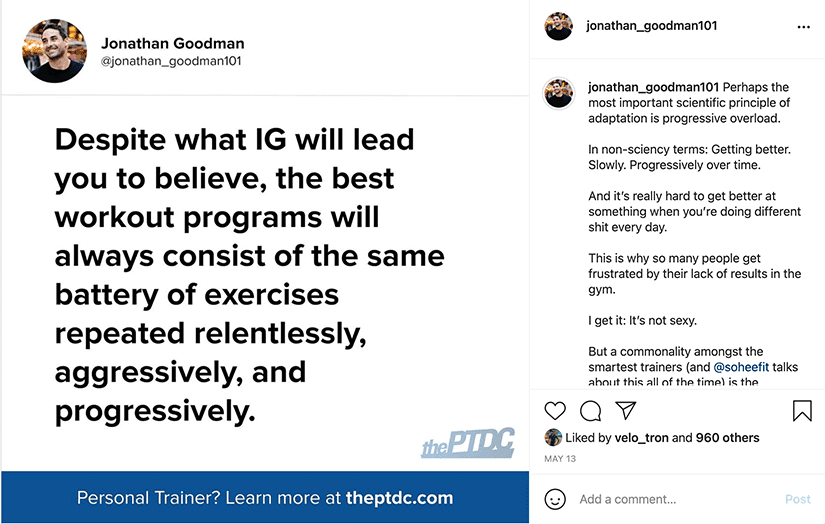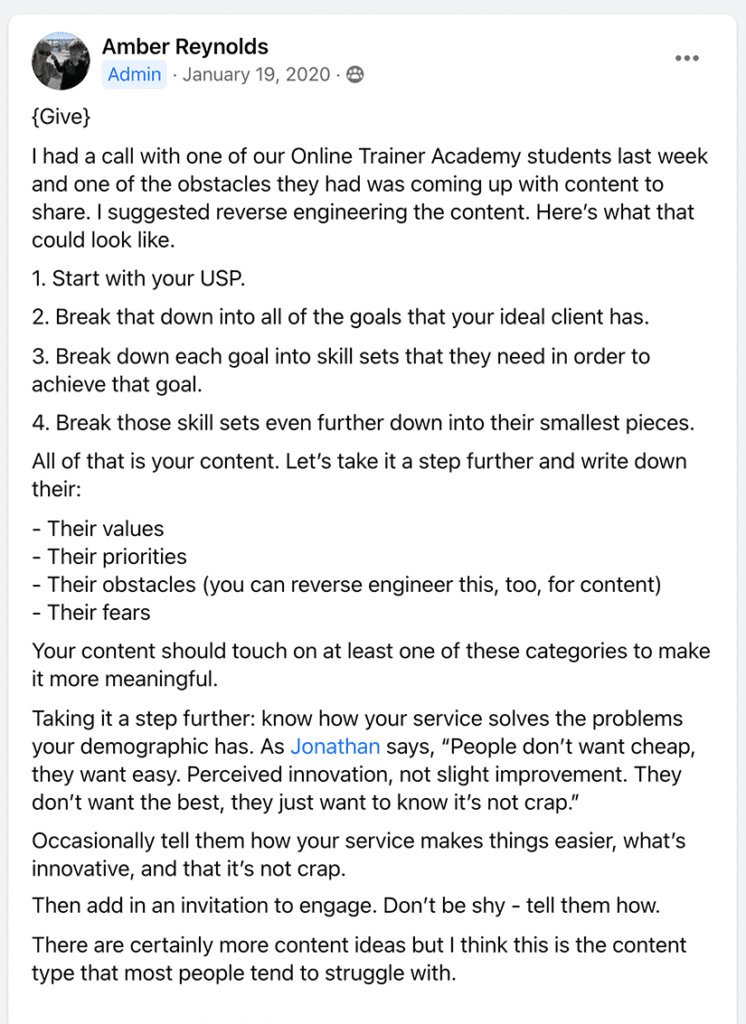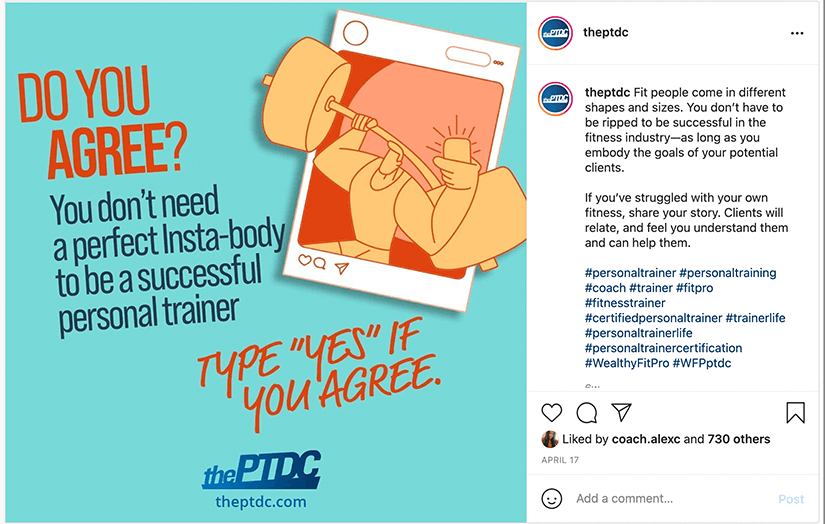Quality content, whether it’s in a video, podcast, or social media post, is the key to connecting with potential and existing clients and taking your online fitness or nutrition business to the next level.
Here’s how to do it better.
13 content writing and marketing tips every fitness and nutrition coach must know
1. Stop making things so complicated
Trainers see other coaches creating infographics or doing podcasts or live-streams, and they want to do all that too. But it doesn’t have to be so hard.
Content can be as simple as a text post. That’s it, and that’s fine.
Of course, you want to offer valuable health and fitness content, but it doesn’t need to be peer-reviewed, journal-style stuff.
Just talk to your target client, keep it simple, don’t overexplain, and don’t go off on tangents.
Try to focus on your zones of genius. If you’re terrified to be on video, don’t feel like you have to be on video. But if you’re a really good writer, focus on that.
2. Be mindful of your audience
You’re not going to know your target audience 100 percent out of the gate. It’s something that comes with time.
But don’t let that stop you from going with what you know now. If your target market is working moms, then talk to them with your current understanding of what a working mom is going through and let your knowledge evolve.
To help you better learn their language and interests, try participating in their communities, conversing with them and, most important, listening.
A lot of fitness and nutrition coaches tend to talk to clients like they’re in our industry and fill their content with jargon or terms clients don’t understand.
I tell our Online Trainer Academy students to write at a ninth-grade reading level or lower. Anything more complicated than that, and you’re probably going to lose them.
Try to make sure you’re talking to your ideal client, not to “everyone.”
One student made a really good comparison: Imagine you have a crush on someone, and you're posting content just for that person because you want to make them smile.

Same deal here. When we try to talk to everyone we miss the opportunity to really help people in a meaningful way.
3. Post consistently
Look—we don't live in a vacuum. You may have a full-time job already, a family, or other responsibilities.
If you can't post every day, it's O-K-A-Y.
Find what is doable and do that—consistently. If you can realistically post three times per week, great, do that. For content marketing, consistency is more important than frequency.
What you don’t want to do is get into a situation where you’re feeling guilt or shame, or you’re putting out poor-quality stuff because you’re rushing and posting just to post.
(Find out how to promote personal training on Instagram without getting half-naked.)
4. Have fun!
Don't feel like you have to educate with every post. People go on social media to be social and browse, usually not to learn. Save the hard-core learning for paying clients.
Instead, be lighthearted and fun. If you like memes, use memes. If you like poetry, then make all your posts haikus (and if you do, please tag me!).
One student of mine focuses on Brazilian Jiu-Jitsu athletes. A post could be something as simple as:
“Who's your favorite BJJ athlete?”
or
“What BJJ move do you want to master?”
One of our Online Trainer Academy Level 2 graduates, Carolina Belmares, gets playful in this post about "screaming butts."
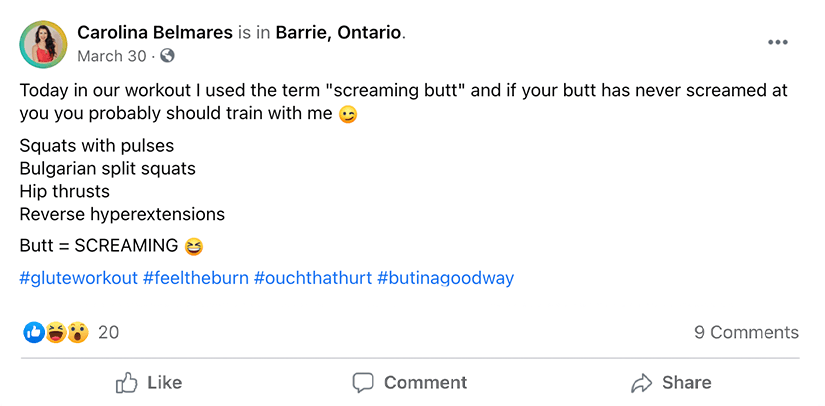
The fact is people are so scared nowadays of being authentic and potentially turning people off, that it becomes a hindrance.
Being polarizing can be okay, because you want to pull the right people to you. If your brand of humor doesn’t work for everybody, that’s not necessarily a bad thing.
For example, I don’t want to work with someone who is super into politics, so I don’t post that type of content because I don’t want to draw that crowd.
But I do curse a lot. I grew up in the Marine Corps, and I want to work with people who aren’t going to be offended if I drop an f-bomb now and then.
So your content needs to reflect who you are. Don’t be afraid of this, but do it intelligently.
Communicate and have fun in ways that will pull the people who are going to appreciate that. The goal is to feel comfortable being who you are and to have fun in your business.
5. Really target your audience and their needs
Like I said earlier, you want to be continually learning about and zeroing in on your ideal client—specifically their needs and their language. I can’t emphasize this enough. Here’s a FB post I did on how to make posts even more targeted:
6. Use these keyword research tools
Here are a couple of really cool tools you can use to learn more about your target audience and also find things to talk about when you’re stuck:
- AnswerThePublic pulls search-engine data for particular keywords. So, for example, if my target market is working moms who want to lose weight, I can type in “working moms/lose weight,” and it’ll display all the searches with those keywords. It’s not only a window into how they think and what they’re worried about, but you can then answer some of those same questions in your posts. It’s like reading their minds.
- AlsoAsked is similar, but it takes things a step farther. If someone asked, “How does a working mom lose weight?” it will tell you that the people who searched that also searched X. And it just goes farther and farther out. The related searches can get pretty funny—which can lead to some interesting posts!
7. Listen to these podcast episodes
Here are a couple of links to really helpful Online Trainer Show podcast episodes from the Academy on content creation that you should listen to, if you haven’t already:
#71 - Your Content Is Your Life
#68 - How to Be a Content-Creating Machine
*And if you want to see what it means to have fun with your work, definitely listen to these episodes.
8. Maximize your content
Anything you make—milk it. When I feel inspired and particularly chatty, I will sometimes do a live or record a video and share it.
So let's say that the video is 10 minutes long. I can:
- pull out 30- or 60-second clips that make good individual points and have those to re-share.
- pull out quotes and create quote cards.
- create an infographic based on the talk.
- redo it in a text format with an image.
- do it as an article if I have a blog.
- turn it into an audio-only clip for a podcast, or do a mini-podcast.
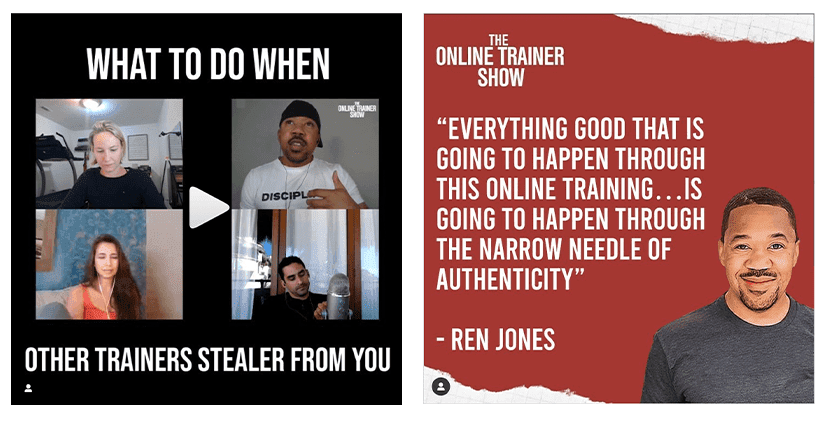
There are a million and a half ways I can maximize that one video.
A lot of trainers are, “Okay I did this thing, now what?” Well, go back and put it in different formats because everyone consumes information differently.
Breaking it down into various formats and then making bite-sized pieces on top of that provides you with a ton of content.
And don’t be shy about recycling it. People need to have the most important information pounded into their heads over and over.
They’re not going to take action on it the first five times; it’s probably the eighth or tenth time that they may say, “Okay, maybe I’m ready to do this.”
9. Track the performance of your posts
A big piece of successful content creation comes down to knowing what works and why. Then you can enhance those features and double down on success.
How you track performance might vary slightly between platforms, but you’re looking for posts that got people to engage with you.
Things I’d use to gauge performance include:
- Did it get a lot of reactions?
- Did it get comments?
- Did it get shared?
Resource: Download this free social media tracker template to help you get started.
If it got zero engagement, that doesn’t necessarily mean it was a bad post, but you can try reposting it at a different time or in a different way. Maybe it just needs to be tweaked.
Experiment instead of ditching the idea altogether.
Save the posts that do well. They struck a nerve and can be recycled. This doesn't mean you can't tweak your recycled posts (you often should), but they can remain mostly original.
Once you have 30 days’ worth of good content, start sprinkling in these recycled pieces. Once you hit 60 days, most of your posts can be recycled, with new ones just being more relevant.
10. Start simple on a single platform
Coaches often feel like they need to be on the latest social media platforms.
My best advice? Pick one, do it really well for six months, then if you feel like you have space to do another platform and want to, go for it.
Just know that chances are you won’t need more than one platform. In other words, keep it simple and manageable early on. Don't spread yourself so thin that you drive yourself crazy.
11. Create a swipe file
Swipe files are fantastic. They’re basically inspiration folders for dumping and storing all your great ideas for those days when you feel like you have no new ideas.
So, for example, when I’m browsing Facebook, I save a ton of content—headlines, website structure, articles, graphics, color palettes … really anything that catches my eye.
I put them in specific folders with those same names and note why I liked them. Then whenever I’m feeling like I don’t know what to do or what to talk about, I go through my swipe files.
Save a copy of my personal swipe files to help you get started.
You can either use them as inspiration or share a post/content with credit. In fact, it’s even better if you tag the original source; people tend to share content they're part of.
12. Document and celebrate everything
Positivity begets positivity.
Got a nice message from a client? Take a screenshot.
Client broke through a plateau? Screenshot the graph.
Got your first client in another state/province/country? Share about it.
Thinking about adding a service or changing something about your business?
Post about it and ask for input. (Even if you know the answer, people love giving their opinion.)
13. Make sure you’re asking for something in return
Although the purpose of what we do is to help people, we also need to make money. All this content we’re generating should lead to sales.
So occasionally we have to ask for two things:
- Engagement
- The sale
Asking for engagement is literally that—ask them to participate in the post. You can ask them to tag a friend who should see the post, or ask them a question so you can comment on their answer.
Asking for the sale is where you provide an opportunity for people to raise their hand in interest. For example, you might end a post with:
“If you’re X-type of person who wants to Y, comment ‘tell me more’ below and I’ll reach out with more information.”
We have to ask for what we want and provide opportunities for people to work with us.
Bonus: How to boost your reach
Early on, we have to do a lot more giving before we can receive. The more social we are, the more likely it is our content will be seen.
If you want to help boost your reach, be more social.
Respond to people who comment on your posts, comment on other people’s posts, and start private conversations.
We need to use social media the way it was intended, and that is to be social.
Build an online business that's perfect for you.
The Online Trainer Academy teaches you a flexible framework that adapts to you and your unique needs, so you can have the business and life perfect for YOU. We promise you’ll make at least $1,000 in 90 days, or we’ll give you a full refund.



